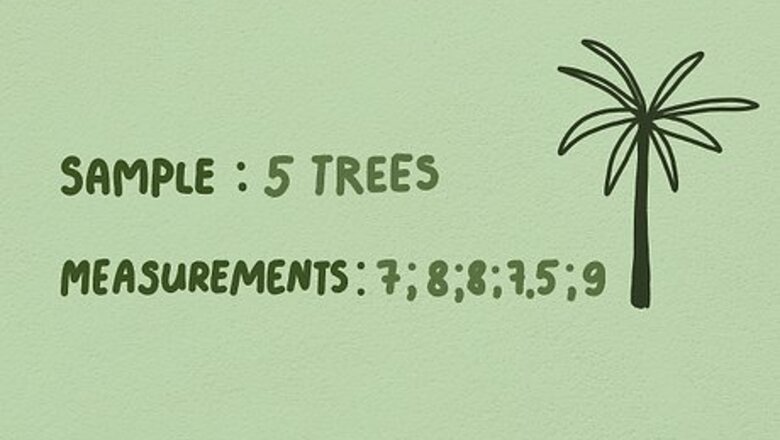
views
X
Trustworthy Source
Simply Psychology
Popular site for evidence-based psychology information
Go to source
To find the Z score of a sample, you'll need to find the mean, variance and standard deviation of the sample. To calculate the z-score, you will find the difference between a value in the sample and the mean, and divide it by the standard deviation. Even though there are lots of steps to this method from start to finish, it is a fairly simple calculation.
Calculating the Mean
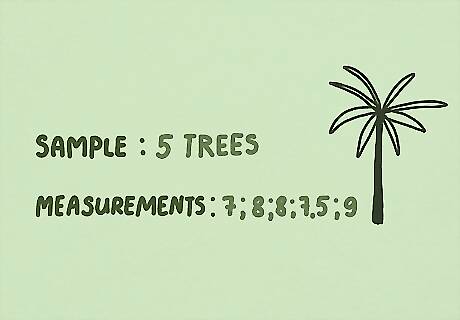
Look at your data set. You will need certain key pieces of information to calculate the mean or mathematical average from your sample. Know how many numbers are in your sample. In the case of the sample of palm trees, there are 5 in this sample. Know what the numbers represent. In our example, these numbers represent measurements of trees. Look at the variation in the numbers. Does the data vary across a large range, or a small range?
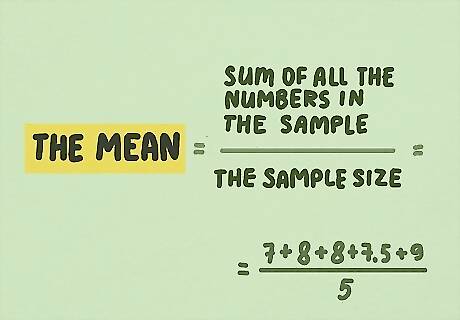
Gather all of your data. You will need all the numbers in your sample to start your calculations. The mean is the average of all the numbers in your sample. To calculate this you will add all the numbers in your sample together, then divide by the sample size. In mathematical notation, n represents the sample size. In the case of our sample of tree heights, n = 5 since there are 5 numbers in this sample.

Add all the numbers in your sample together. This is the first part of calculating the mathematical average or mean. For example, using the sample of 5 palm trees, our sample consists of 7, 8, 8, 7.5, and 9. 7 + 8 + 8 + 7.5 + 9 = 39.5. This is the sum of all the numbers in your sample. Check your answer to make sure you did your addition correctly.
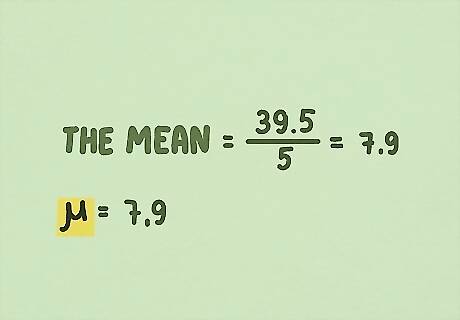
Divide the sum by your sample size (n). This will provide the average or mean of the data. For example, use our sample of tree heights: 7, 8, 8, 7.5, and 9. There are 5 number in our sample so n = 5. The sum of tree heights in our sample was 39.5. You would then divide this figure by 5 to figure out the mean. 39.5/5 = 7.9. The mean tree height is 7.9 feet. The population mean is often represented by the symbol μ, therefore μ = 7.9
Finding the Variance

Find the variance. The variance is a figure that represents how far your data in your sample is clustered about the mean. This calculation will give you an idea about how far your data is spread out. Samples with low variance have data that is clustered closely about the mean. Samples with high variance have data that is spread far from the mean. Variance is often used to compare the distributions between two data sets or samples.
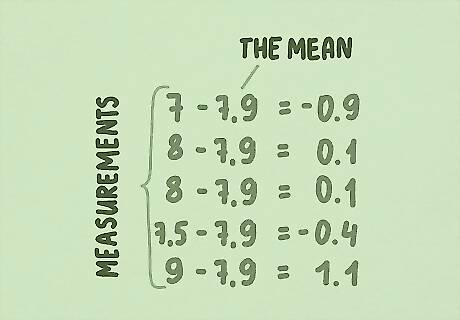
Subtract the mean from each of the numbers in your sample. This will give you an idea of how much each number in your sample differs from the mean. In our sample of tree heights (7, 8, 8, 7.5, and 9 feet) the mean was 7.9. 7 - 7.9 = -0.9, 8 - 7.9 = 0.1, 8 - 7.9 = 0.1, 7.5 - 7.9 = -0.4, and 9 - 7.9 = 1.1. Do these calculations again to check your math. It is extremely important that you have the right figures for this step.
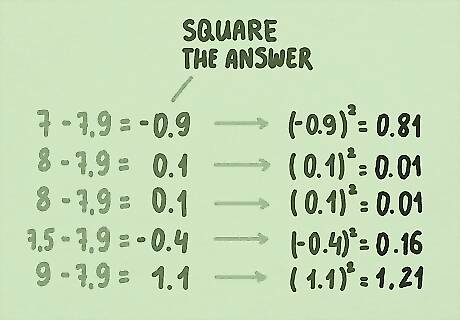
Square all of the answers from the subtractions you just did. You will need each of these figures to figure out the variance in your sample. Remember, in our sample we subtracted the mean of 7.9 from each of our data points (7, 8, 8, 7.5, and 9) and came up with the following: -0.9, 0.1, 0.1, -0.4, and 1.1. Square all of these figures: (-0.9)^2 = 0.81, (0.1)^2 = 0.01, (0.1)^2 = 0.01, (-0.4)^2 = 0.16, and (1.1)^2 = 1.21. The squares from this calculation are: 0.81, 0.01, 0.01, 0.16, and 1.21. Check your answers before proceeding to the next step.
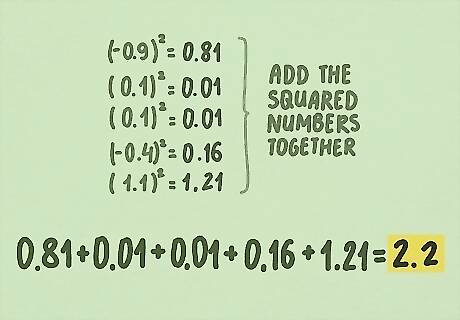
Add the squared numbers together. This calculation is call the sum of squares. In our sample of tree heights, the squares were as follows: 0.81, 0.01, 0.01, 0.16, and 1.21. 0.81 + 0.01 + 0.01 + 0.16 + 1.21 = 2.2 For our example of tree heights, the sum of squares is 2.2. Check your addition to make sure that you have the right figure before moving on.
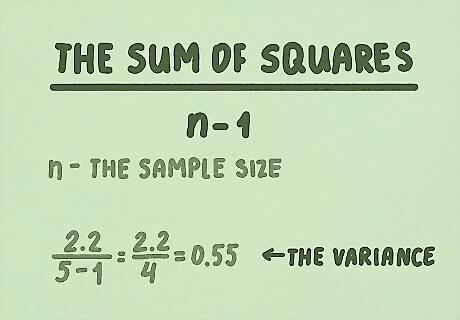
Divide the sum of squares by (n-1). Remember, n is your sample size (how many numbers there are in your sample). Doing this step will provide the variance. In our sample of tree heights (7, 8, 8, 7.5, and 9 feet), the sum of squares was 2.2. There are 5 numbers in this sample. Therefore n = 5. n - 1 = 4 Remember the sum of squares is 2.2. To find the variance, calculate the following: 2.2 / 4. 2.2 / 4 = 0.55 Therefore the variance for this sample of tree heights is 0.55.
Calculating the Standard Deviation
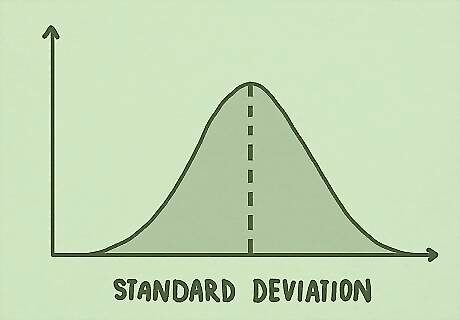
Find your variance figure. You will need this to find the standard deviation for your sample. Variance is how spread out your data is from the mean or mathematical average. Standard deviation is a figure that represents how spread out your data is in your sample. In our sample of tree heights, the variance was 0.55.
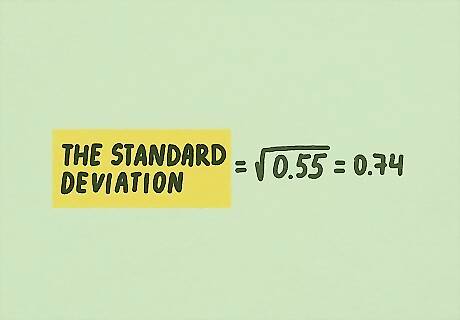
Take the square root of the variance. This figure is the standard deviation. In our sample of tree heights, the variance was 0.55. √0.55 = 0.741619848709566. You will often get a very large decimal figure when you calculate this step. It is ok to round to the second or third decimal place for your standard deviation figure. In this case, you could use 0.74. Using a rounded figure, the standard deviation in our sample of tree heights is 0.74
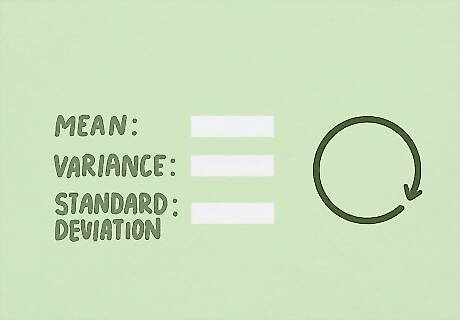
Go through finding the mean, variance, and standard deviation again. This will allow you to make sure you have the correct figure for standard deviation. Write down all the steps you took when you did your calculations. This will allow you to see where you made a mistake, if any. If you come up with different figures for mean, variance, and standard deviation during your check, repeat the calculations looking at your process carefully.
Calculating Z Scores
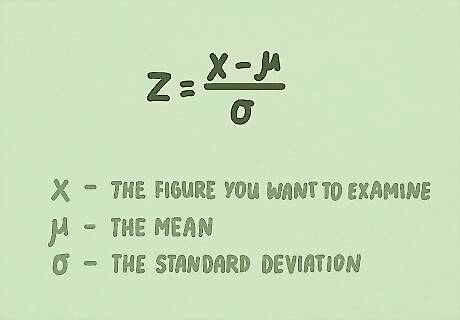
Use the following format to find a z-score: z = X - μ / σ. This formula allows you to calculate a z-score for any data point in your sample. Remember, a z-score is a measure of how many standard deviations a data point is away from the mean. In the formula X represents the figure you want to examine. For example, if you wanted to find out how many standard deviations 7.5 was from the mean in our example of tree heights, you would plug in 7.5 for X in the equation. In the formula, μ stands for the mean. In our sample of tree heights the mean was 7.9. In the formula, σ stands for the standard deviation. In our sample of tree heights the standard deviation was 0.74.
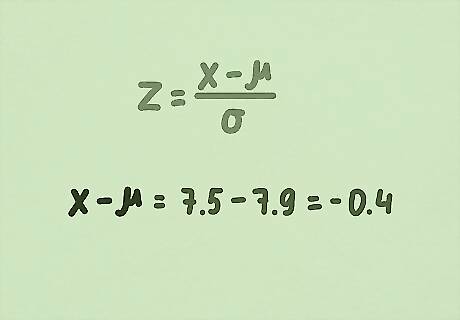
Start the formula by subtracting the mean from the data point you want to examine. This will start out the calculations for a z-score. For example, in our sample of tree heights we want to find out how many standard deviations 7.5 is from the mean of 7.9. Therefore, you would perform the following: 7.5 - 7.9. 7.5 - 7.9 = -0.4. Double check that you have the correct mean and subtraction figure before you proceed.
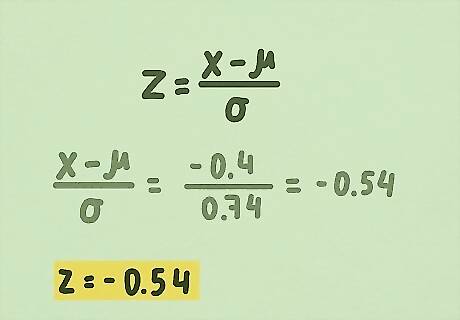
Divide the subtraction figure you just completed by the standard deviation. This calculation will provide you with your z-score. In our sample of tree heights, we want the z-score for the data point 7.5. We already subtracted the mean from 7.5, and came up with a figure of -0.4. Remember, the standard deviation from our sample of tree heights was 0.74. - 0.4 / 0.74 = - 0.54 Therefore the z-score in this case is -0.54. This z-score means that 7.5 is -0.54 standard deviations away from the mean in our sample of tree heights. Z-scores can be both positive and negative numbers. A negative z-score indicates that the data point is less than the mean, and a positive z-score indicates the data point in question is larger than the mean.



















Comments
0 comment